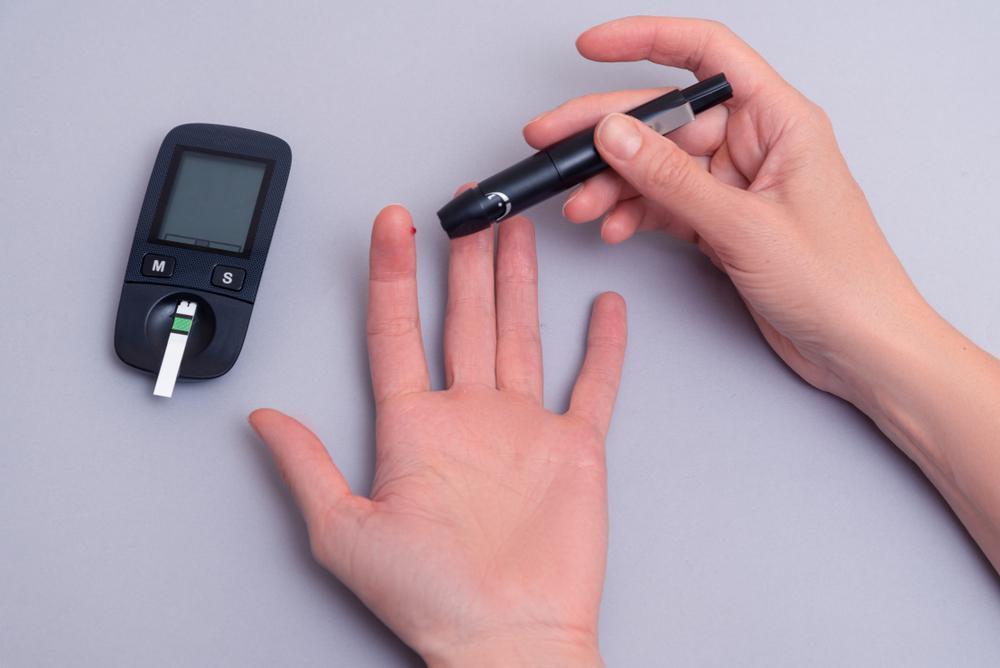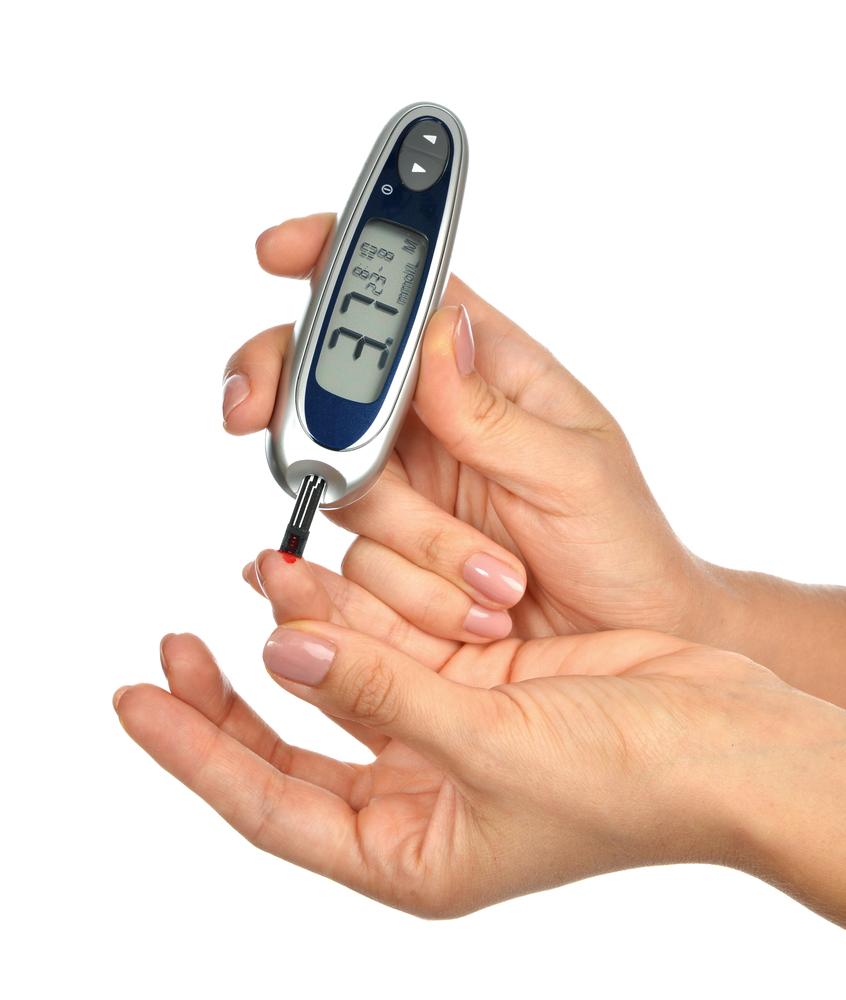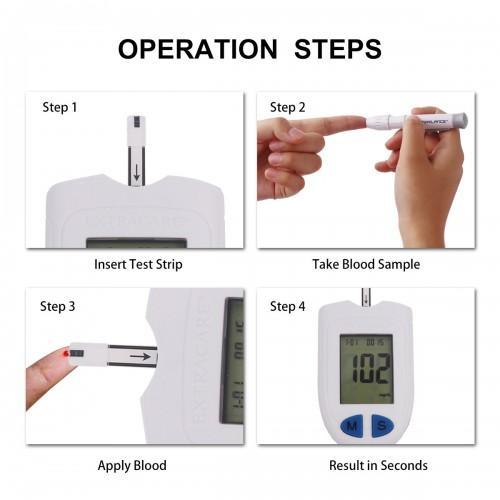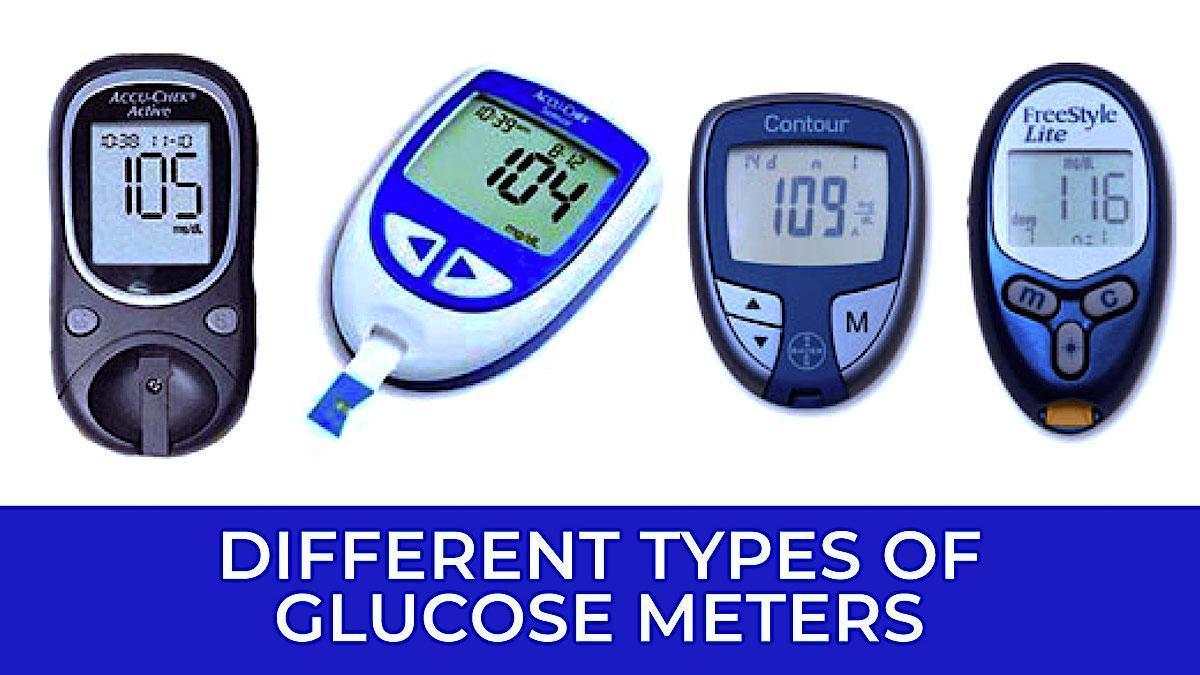Last updated on April 18th, 2022

Monitoring the blood sugar level is an important part of diabetes management. This will help you to know what kind of activities or food is responsible for increasing your blood sugar level. It also helps you to control your diabetes from reaching the fatal limits. There are several ways to monitor your blood sugar but for most of the diabetes tests, you need to visit the laboratory. If you want to monitor your blood sugar at home then glucometers are the best. Read this blog to know how to use glucometer to check blood sugar.
Also Read: Triglycerides apple cider vinegar

What is Glucometer?

Glucometer has now become an integral part of the lives of diabetes patients. These are small-sized portable device that requires a drop of blood to measure your blood sugar level in real-time. A glucometer provides the readings by detecting the blood glucose content in your body with the help of glucometer strips. These strips contain some kind of chemicals that gives out the electric signals when blood comes in its contact. Therefore, you get the numerical results within a few seconds.

Principles on Which the Glucometers Work
The three most common and popular glucometer principle includes:
- By glucose oxidase
- By glucose dehydrogenase
- By glucose dye oxidoreductase
Some meters and strips are coded. If you are using the glucose oxidase meter, it can interfere with your blood oxygen level and you will get the altered results. Similarly, glucose dehydrogenase can interfere with maltose and galactose contained in the solution for infusion. Therefore, the accuracy of the test result gets altered if you use the test strips of one glucometer on the other. This happens when the code on the test strips does not correspond to the code setting of your glucometer.
Who Should Use a Glucometer
Regular testing of the blood sugar levels using a suitable glucometer should be done if anyone has been diagnosed with type 1 diabetes, type 2 diabetes, or gestational diabetes during pregnancy. This is the most important part of the treatment plan.
Frequent usage of glucometer helps in:
- Checking the control over blood sugar and checking whether the levels are high or low.
- Observe the responsiveness of sugar levels after a person does exercise or when he or she is stressed.
- Identifying the patterns when there is more spike or crash in sugar levels.
- Evaluating how well a person is able to meet his or her treatment goals.
- Regulating the effects of anti-diabetic drugs or other therapies.
When to Use Glucometer to Check Blood Sugar
It is a must to check with the concerned healthcare provider about the frequency, at what times of the day a test is required, and what should be done if the test results are low or high. How often a test is required depends upon patient’s type of diabetes and his or her treatment plan.
- Type 1: If a person has type 1 diabetes, he or she must test their sugar levels 4-10 times a day. The person can test prior to food intake (may it be, meals or snacks), before and after exercising, before going to bed, and also at night. As type 1 diabetes is characterized by the inability to form enough insulin. Thus, a person must check more often to confirm that the person has adequate insulin to keep his or her blood sugar within the required limits.
- Type 2: If a patient has type 2 or gestational diabetes, testing can be done 2-4 times per day, based upon whether insulin is being used or not. Usually, the person can test before taking
First-Time Testing Tips
There are some useful tips for first-time users about glucometers:
- Also, the setting of the lancing device can be adjusted to determine the distance of penetration of the needle into the skin. For example, the lancet can be adjusted to the number 2 mentioned on it, and if that fails to work, the person can increase the number by turning it round.
- If any person observes the process very painful, then lancet thickness must be changed. Lancets are available in many gauges (thicknesses). Number is mentioned on the lancet, the higher the number is, the thinner will be the lancet. For example, a 30 gauge lancet is more comfortable than a 21 gauge lancet.
- The test strips are particular for a particular glucometer.
Simple Steps to Use the Blood Sugar Test Machine (Glucometer)

With the help of a portable and mobile-based glucometer, it is possible to monitor your blood sugar level anywhere anytime. One has to follow the instructions mentioned in the user manual provided with the kit to use the glucometer effectively. All you need to be ready with a glucometer, the test strip, lancing device, lancet, an alcohol pad to get started with the blood test machine.
Following are the steps that one needs to follow to use the blood sugar test machine:
Step 1: Preparation of Lancing Device
First step to measure your blood sugar level is to prepare the lancing device and for this you need to follow these steps:
- The internal cap of the lancing device is twisted and removed so that the mounting part of the lancet insertion opens up
- You need to hold the lancet from its circular tip and then insert it into the mounting part of the device. The protective circular tip is then rotated to make it use.
- Internal cap is then re-attached to the mounting part of the device
- Select the depth of the blood sample between the range 1 and 5 where 5 means the deepest penetration
- Hold the lancing device and then pull on the sliding barrel. You should stop when you hear the click sound. It will release the button of the lancing device and make it ready for puncturing to get your blood sample.
Step 2: Cleaning Hands and Glucometer
Clean your hands and glucometer: You should clean your hands every time you use a sugar level test machine. Use a good handwash solution and gently rub your hands for atleast 20 seconds thoroughly. In case, you are outside and unable to wash your hands then you can use alcohol swab to clean your hands. Now completely dry your hands specially fingers by gently dabbing it on a towel. Now rub your palm softly so that the blood in your fingers gets warmed up.
Step 3: Preparation of Glucometer and the Strips
You should switch off the glucometer before inserting the blood sugar strips. Now you need to insert the glucose test strip in the glucometer’s test strip port ensuring that the contact bars face upwards. The glucometer will start automatically with a beep sound when the strip gets in its contact.
Step 4: Take the Blood Sample and Monitor Blood Sugar Level
When your device is ready for testing the blood sugar, you just need to get your blood sample and monitor your blood sugar. For this, you should follow the below mentioned steps or the instructions written on the test kit box:
- Firstly, you have to place the prepared lancet against the pad on your finger once your glucometer is ready.
- Now gently press the trigger button to get your finger punctured. In this way, a drop of blood will come out of your finger. Checkout the type of blood drop required by your glucometer. Some devices use the hanging drop of blood while the others are one touch sugar test machine. A small drop of blood is used and drawn in with capillary action.
- A blood sample is hence applied on the narrow end of the already inserted sugar testing strip.
- Wait for around 5 seconds to get the most accurate results. You will get the results given in g/l, mg/dl, or mmol/l. You can get mislead if you do not pay attention to the unit of calculated reading.
Also Read: Normal Blood Sugar Levels Chart Age Wise
Step 5: Dispose of the Used Lancet and Test Strips
You need to clear the blood from the fingertip after a sugar level check. Twist and remove the internal cap to open the mounting part of the lancet. The lancing device is cocked again after the round protective cover is removed and the lancet needle is inserted into it. Remove the lancet when the lancing device is locked. Now, you throw away the removed lancet and the sugar strips into the dustbin.
Reasons for Not Getting the Accurate Readings on the Glucose Meter
Summary
Many reasons are there that can affect the accuracy of a glucometer. If you want to get accurate results, you should avoid the mistakes that can lead to inaccurate results. Additionally, follow the instructions properly for sampling, calibrating your device, and taking a reading. It helps you to get accurate results and take the correct treatment to manage your blood sugar levels.
There are chances that you may get an inaccurate reading on a glucometer. Some possible reasons include:
- Storage of the glucometer strips near excessive heat or where the room temperature is more than 30 degrees centigrade can affect the accuracy of blood glucose reading.
- An insufficient quantity of blood for testing blood glucose gives you the wrong reading. When the drop of blood taken for testing does not fully cover up the test area or the test area dries up before the completion of the testing, it means that you have taken an insufficient quantity of blood.
- Use of the wet punctured site for sampling after cleaning it with alcohol or spirit.
- Use of defective and low batteries.
- Immediately change the batteries when it shows they are weak.
- The calibration process, enzymes, and computer programs (algorithms) in every glucose monitoring meter are different. If you use the glucose monitor of one brand in the morning and of another brand at night, you may get variations in the results.
- The frequency of circulation of fresh blood in your body also affects the readings on the glucometer monitor. Taking the blood sample from the other sites like forearm, thigh or calf, often gives you the less accurate result than testing from your fingertips.
- Test strips are sensitive to temperature and humidity. Thus, testing the blood glucose in the extreme temperature and humidity can affect the readings on the Glucose monitoring device.
- The use of expired and damaged test strips also prevents you from getting accurate readings.
- You may get inaccurate readings if you are unable to calibrate your glucose monitoring device properly. If your glucometer monitor requires coding, you need to enter the correct code to calibrate your device before use.
Common Problems to Avoid
Maintenance of glucose meter is required in order to avoid potential issues. Some tips for good functioning of a glucometer are:
- Glucose meter device must be cleaned at regular intervals and QC checks must be run when prompted.
- Batteries must be kept in stock fitting the glucometer.
- Expiry date of the test strips must be checked as expired test strips delivers inaccurate outcomes usually.
- The lid should be closed tightly after taking a test strip out. An excess of light or moisture might damage the strip.
Tips for Kids
It’s important to get your child tested for glucose levels if they have been diagnosed with diabetes (type 1 or type 2, type 1 being more common).
Getting your child accustomed to frequent glucose testing comes with the following benefits:
- The child can become aware of the impact of foods, exercises, and medications on the levels of blood glucose.
- He or she can get a feeling of control over what’s occurring in his or her body.
- Children must test more often in comparison to adults, particularly if they are on insulin. Also, kids with problems of hypoglycemia episodes must require testing during mid of night, and also when they are feeling ill.
Types of Glucose Meters
Summary
Non-invasive, continuous monitoring, and invasive glucose monitoring devices are there. They work in different ways to give you the blood glucose test results. Non-invasive glucose monitoring devices are painless and measure your blood glucose levels through bio-fluids in your body. Continuous monitoring devices make use of a transmitter attached to an electrode placed under your skin to monitor your glucose levels continuously. Invasive meters are the most popular ones.
There are different types of glucose monitoring devices available in the market. If you are not sure about the most suitable type of glucose monitor for you, here is a list of some popular devices:
Non-invasive Glucose Meter
This type of glucometer monitor allows monitoring of the blood glucose without drawing blood or puncturing the site. Such glucometers use optical methods, microwave methods, and electrochemical methods to detect blood glucose levels. Non-invasive glucose meters utilize the coherent correlation between bio-fluids and blood glucose values. There is a considerable amount of glucose in the bio-fluids of your body that helps in calculating your blood glucose levels after calibrating the device.
Continuous Glucose Monitor
Some diabetes patients need to monitor their blood sugar levels continuously throughout the day. Thus, a continuous glucose monitor (CGM) is a perfect choice for them. It allows the diabetes type-1 and type-2 patients to take the blood glucose readings at the set intervals. A small electrode is placed under your skin and held at a place with the help of an adhesive. There is a transmitter attached to the electrode that sends data to the receiver.
Invasive Glucometers or the Glucometer With Testing Strips
Blood testing meters that use testing strips are the more popular type of glucose meter in the market. There are lots of brands that manufacture such type of glucose monitoring device. They are simple to use and give accurate results. These are portable, easy to use, and invasive glucose meters. You need to use your blood sample to test your blood sugar levels. They are affordable as well. The characteristics of invasive glucose monitoring devices differ from one model to another. Some of the features of invasive glucose monitors are:
- Size: Blood glucose monitors are available in different sizes. You can find the glucometer from the palm held size to the glucometer of the remote control size.
- The volume of blood sample: Different models of glucose monitors need different volumes of a blood sample for measuring your blood sugar levels. The quantity of the blood sample for testing varies from 0.3 to 1 μl. The older models require more volume of blood samples than the latest models of the glucose meter.
- Reading-based on glucose versus plasma glucose: Glucose levels in plasma is higher than the glucose level in the whole blood. Many glucose monitoring devices are available in the market. They measure the blood sugar levels as “plasma equivalent” instead of measuring the sugar levels in the whole blood. Patients and their healthcare providers should know if their glucose monitor gives “whole blood equivalent” or “plasma equivalent” as a result.
- Display: The glucose monitors display the blood glucose value in mmol/l or mg/dL. The preferred measurement varies from country to country. Therefore, the buyer should check the unit of measure of the glucometer device before buying. Many meters display either of units of blood glucose measure. It is sometimes misleading to diabetes patients and healthcare providers. They may get into the wrong action if they mistake the unit of measurement.
- Memory: Many meters now have the clock feature. Therefore, making it convenient for diabetes patients to remember the date, the time, and the results of the past test. Memory is an essential aspect of diabetes management. It enables the diabetes patient to keep a record of their blood sugar tests. Hence, they can look for the trend and patterns in the blood glucose levels over the past few days or weeks.
- Data transfer: Advanced glucose monitoring devices are now capable of handling the data. Some meters allow downloading the data into a computer with diabetes management software to display the blood sugar test report. Other meters enable data transfer to smartphones through Bluetooth technology or syncing a related app. You can even find the meters that allow additional data entries like insulin dose, exercise, or intake of carbs.
Also Read: List of Best Iron Supplements for Type 1 Diabetics
Advanced features and new developments in the blood glucose monitoring device
Summary
If you are looking for a glucose monitoring device with an advanced feature, look for the latest models of glucometers. These days, lots of brands are manufacturing tech-friendly glucometers. However, you may have to pay more for buying such glucose meters.
The latest models of glucometer devices integrate some advanced features. The advanced features that you can find in the glucometers include the wireless connection, multi-parameter mode, and speaking mode.
- Wireless network models: The wireless network models of glucose monitors make it easier to send the data to a tracking platform.
- Multi-parametric models: Monitors with the multi-parameter feature integrate the features of a thermometer, lactometer, and ketosis reader to measure other parameters as well. It is suitable for the patients suffering from other health issues along with diabetes.
- Speaking mode models: Meters with speaking mode are suitable for people with visual impairments. They do not need manual coding but allow step by step vocalization process. It help such diabetes patients to do self-monitoring of their blood glucose levels.
Also Read: CRP Normal Levels Chart For Adults
Technology Enabled Glucometers
Glucometer manufacturing companies are now featuring technologies in the meters. They are currently using different measurement technologies to monitor your blood sugar level. You can sync latest and tech-friendly glucometers with an app, website or cloud. Some glucometers allow you to store your data on app or website synced with them while others will allow you to store readings in their own memory.
Popular Options Available in Tech-friendly Glucometer Machines

There is wide range of glucometer machine available in the market. Some of the affordable and popular options are:
- Wireless network model: In this type of glucometer, blood sugar level logs are sent to the tracking platform through Bluetooth or Wi-Fi.
- Glucometers with speaking mode: Such glucometers easy for those who have visual impairments. They simply vocalise the process to use diabetes test machine to complete the test without problem. User can hear the final reading of the test result as well.
- Glucometers with multi-parameters: With the help of such type of glucometers, you can measure other parameters as well in addition to the blood sugar level check. Glucometers integrated with a thermometer, ketosis reader, cholesterol reader, lactometer, or more are also there.
Also Read: Is Paneer Good for Diabetes?
Things to Consider While Buying a Glucometer
There was a time when monitoring blood glucose levels were not so easy. People have to visit pathology and wait for their turn to give the blood sample for a glucose test. Thankfully, glucometers have ended the stress of visiting pathology for getting their blood sugar levels checked. If you also want to keep track of your sugar level at home, it is worthy to invest in a quality glucometer. Here are some tips to consider while buying a glucometer:
- Accuracy: Make sure you pick the best quality sugar testing meter that has a good record of accuracy in clinical trials and has got the best reviews.
- Test time: The test time in most of the glucometers is within 5 seconds. It is of no use if you have to wait for longer particularly when you need to test your sugar levels 3-4 times a day.
- Data storage and retrieval: Latest models of blood sugar meters are capable of saving your blood sugar test reports. It helps in tracking and analyzing your blood sugar levels over a period of time. Some technically advanced glucometers have an email facility so that you can easily share your report with your doctor. Some meters are even capable of storing the data of multiple users in a segregated manner.
- Glucometer with automatic coding feature: Some glucometers require manual coding. Thus, every time you start a test using a new box of sugar testing strips. Incorrect feeding of code can affect its accuracy for displaying the results. You will surely get the miscalculated values of your blood sugar levels. Hence, pick the glucometer with an automatic coding feature.
- Maintenance of the meter: Buying a glucometer is a one-time investment but you need to check the maintenance cost of the meter. Make sure it is simple to clean and easy to store. Also, check if it requires calibration or not.
Apart from these, you can also look for the other features in glucometers. You can look for audio compatibility, having USB connectivity mode, the backlight to enhance the readability of the readings. Some glucometers provide multiple test checks. You can check body ketone levels, record carbohydrates grams and insulin dose in addition to the blood glucose level.
Also Read: Is Sapota good for Diabetes?
Blood Sugar range That You Can Check on Glucometer
Most of the blood sugar machines or glucometers allow you to measure blood sugar levels between 20 mg/dL to 600 mg/dL. When you have blood sugar level above 600mg/dL then your glucometer will reads high or HI without giving you the actual reading. In such case, you need to immediately take medical consulation.
Also Read: Homeopathy for diabetes
Cost of the Glucometer
The average cost of the blood sugar test kit ranges from Rs 115 to Rs 4999. You can pick the glucometer from the top brands including Accu-chek, Accusure, Acqua-check, Dr.Morepen and more. Similarly, the average cost of blood sugar test strips is between Rs 500 and Rs 1000 for 50 strips.
Also Read: List of Best Glucometers in India
FAQ’s:
What is the average reading of blood sugar levels on a glucometer monitor?
The readings between 100 mg/dL and 140 mg/dL are average on the glucose monitoring meter during the blood sugar testing at home. Any value of blood glucose beyond this limit is a sign of alarm for uneven blood sugar levels. Therefore, you need to report to your doctor immediately to prevent complications related to high or low blood sugar levels. The doctor may suggest: Fasting blood sugar test or hemoglobin A1C blood test before starting your diabetes treatment.
Why are the readings of the lab not the same as my monitor reading?
Most glucometers use whole blood to monitor blood glucose levels. Lab equipment uses the plasma of the blood to monitor blood glucose levels. Lab testing does not consider red blood cells for monitoring blood glucose. Thus, you get the different readings of blood glucose monitoring due to the different types of blood samples. Blood glucometers generally have up to 20% error accuracy. Heat, humidity, and low temperature also affect the readings on glucometers so, you may get different results.
Is there a need to disinfect the glucose monitoring device after every use?
FDA provides some guidelines to the manufacturers to provide suitable products and procedures to clean and disinfect the glucometers. Note that 70% ethanol solutions are ineffective in killing viruses or blood-borne pathogens, whereas 10% bleach solution can damage the device. Therefore, you should use the cleaning solution available with glucometers. It is even better to the glucometer monitors designed for single-patient use to reduce the chances of infection.
Does squeezing your finger hard for the blood sampling affect your blood sugar levels?
When you monitor the blood glucose levels with the help of a glucometer, follow the instructions carefully. Squeeze the fingers hard to get a drop of blood can affect your blood sugar levels. Rub your palm against each other to warm the blood in your hand. It will allow the collection of a blood sample for monitoring blood glucose levels on a Glucometer easily. Press the finger gently to allow a drop of blood to come out of your finger.
How many can I use the lancet of the glucometer monitor?
The manufacturers recommend using a Syringe and lancet of the blood glucose monitor device one time only. Users need to change the lancet after every single use. It helps them to get a hygienic reading. The new lancet allows proper sampling of the blood for reading and makes skin penetration safe. The lancet does gets expire. Therefore, check the expiration date on the lancet box to avoid using the expired lancet. If you have the glucometer device, you need to buy the new lancet box only upon the expiration of the lancet.
Are the glucometers affordable?
Yes, the glucometers are affordable. Nowadays, you can easily find the cheap and reliable glucometers that costs you comparatively less than making several visits to pathology for blood sugar test.
Can glucometer test strips of one glucometer be used with the other glucometer?
No, not all the sugar test strips are compatible with all the glucometer. Different glucometers have different test strips to measure the blood sugar level correctly. Thus, you should refer to the product page of the brand of which you have purchased the glucometer to buy the right test strips.
What to do when glucometer shows an error message?
If you face any problem in using glucometer then your first need to check the ‘troubleshooting’ section in the user manual of glucose monitoring device. In case, if you are not able to fix the error, you can contact the customer care executive for troubleshooting.
From where can I buy glucometer?
You can buy sugar test machine online or from a local medical store. Since these are very common devices these days so you can easily get the glucometers from the top brands as well.
Are the glucometers reliable?
Yes, the glucometers are reliable. You get the most accurate values of your blood sugar level.
Reference:
- http://guide.medicalexpo.com/choosing-the-right-blood-glucose-meter/
- https://www.verywellhealth.com/how-to-use-a-glucometer-1087304
- https://arcatron.com/how-to-use-glucometer-how-to-test-sugar-at-home/
- https://www.accu-chek.com/management-tips/how-test-your-blood-sugar
- https://prescriptionhope.com/blog-why-is-the-glucometer-reading-high/
Last Updated on by Dr. Damanjit Duggal
Disclaimer
This site provides educational content; however, it is not a substitute for professional medical guidance. Readers should consult their healthcare professional for personalised guidance. We work hard to provide accurate and helpful information. Your well-being is important to us, and we value your feedback. To learn more, visit our editorial policy page for details on our content guidelines and the content creation process.

 English
English











